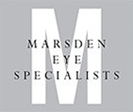If untreated, severe dry eyes can lead to ocular surface damage, ulceration of the cornea, infection and visual impairment. Thus, proper diagnosis of the cause of dry eyes and its timely treatment is very important. Prognosis depends on the severity of the condition. Dry eyes do not cause any permanent vision loss. Symptoms are usually well managed with treatment. Rarely, a corneal ulcer or eye infection may develop which can be treated.
Marsden Eye Specialists are very proud to offer an orthoptic led dry eye clinic to help people suffering from dry eyes and offer effective solutions to their complaints. There is no cure for dry eyes. Treatment strategies depend on whether the problem is temporary or chronic.
The two main strategies include:
- Replacing natural tears with artificial tears by using eye drops
- Letting the tears stay in the eye longer rather than being drained by the lacrimal duct into the nose.
The dry eye clinic is proud to own a machine known as a keratograph. This is cutting edge machine designed to assess multiple components of dry eye disease that are affecting a patient and come up with solutions to help them. Some of the functions that this machine is able to do includes:
- Tear Break Up Time - identifies how long it takes for tears to break up on the surface of the eye and evaporate
- Tear Film Quantity - identifying how much tears are being produced by the eye
- Tear Oil Layer Assessment - tears have an oil component to them which enables them to stick on the surface of the eye, this machien can detect the quality of that oil layer
- Tear Flow Assessment - identifying how easily tears are spread across the surface of the eye
- Red Eye Assessment - quantifies how red the eyes are from the dryness for progression
- Meibography - looks at the oil producing glands under the eyelids
Our dry eye team uses this data, alongside an ophthalmic consultation if needed, to conduct a comprehensive exam and provide treatment strategies based on these parameters. Some of the suggestions for dry eye management have been listed below
Artificial tears
Natural tears contain water, mucin, lipids, lysozyme, lactoferrin, lipocalin, lacritin, immunoglobulins, glucose, urea, sodium, and potassium. No artificial tears can replace natural tears however, they can increase the volume of the tear film when they are in contact with the eye surface. Thus, hydrogels are added to artificial tears to increase their viscosity so that they can remain in the eye longer. Artificial tears contain preservatives to increase their shelf life. Tears with preservatives are more gentle on the eye and are preferred. Some artificial tears also contain other substances that confer additional surface healing and surface protective properties.
Anti-inflammatory eye drops
Topical corticosteroids may be given as a short-term therapy for quick relief (2-4 weeks). Corticosteroid drops may cause cataracts and glaucoma if given for long periods so Cyclosporin drops are given simultaneously. Cyclosporin drops require several weeks and sometimes even 6 months for clinical effect.
Punctal plugs
To conserve tears the opening of the tear ducts may be plugged with punctal plugs. There is one tear duct in the lower eyelid and another in the upper eye lid. One or both can be plugged. Temporary punctal plugs may be collagen or silicone based.
Windless sun glasses
These protect from wind, dust and pollen by sealing the eye space from the outside environment much like swimming goggles.
Treatment for Meibomian gland dysfunction
This condition results in changes in the lipids secreted by the tear glands which leads to increased evaporation of the tears. It is treated by prescribing oral antibiotics, lipid containing eye drops and warm compresses to provide symptomatic relief.
Other strategies to manage dry eyes:
- Decrease or avoid caffeine and alcohol and drink more water.
- Increase omega-3 fatty acids through foods such as fish and flaxseed oil or with oral supplements.
- Keep environmental factors promoting dryness under control.
- Use humidifiers in dry weather conditions.
- Avoid use of room heaters.
- Take breaks while working on a computer for a long time. Keep the screen low or use a laptop as the upper eye lid covers half of the eye while looking down at the laptop screen.
- Avoid smoke and dust.
If you or a family member is concerned about dry eyes and would like to learn more about the dry eye clinic, please contact us to book an appointment with us today.


 n
n